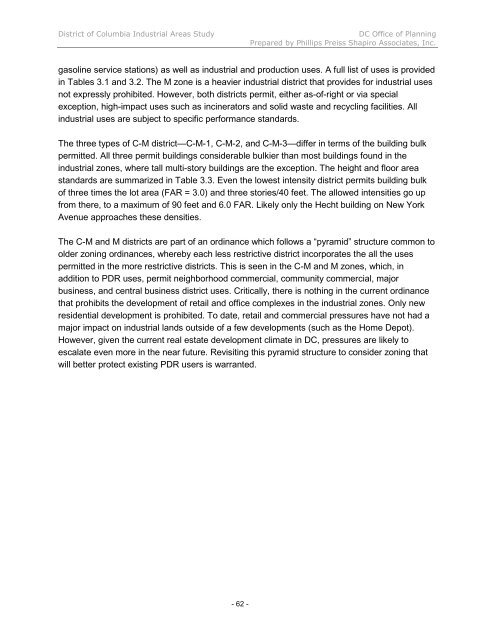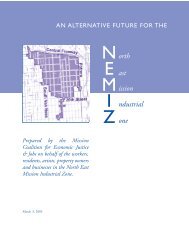INDUSTRIAL LAND IN A POST-INDUSTRIAL CITY District of ...
INDUSTRIAL LAND IN A POST-INDUSTRIAL CITY District of ...
INDUSTRIAL LAND IN A POST-INDUSTRIAL CITY District of ...
Create successful ePaper yourself
Turn your PDF publications into a flip-book with our unique Google optimized e-Paper software.
<strong>District</strong> <strong>of</strong> Columbia Industrial Areas Study DC Office <strong>of</strong> Planning<br />
Prepared by Phillips Preiss Shapiro Associates, Inc.<br />
gasoline service stations) as well as industrial and production uses. A full list <strong>of</strong> uses is provided<br />
in Tables 3.1 and 3.2. The M zone is a heavier industrial district that provides for industrial uses<br />
not expressly prohibited. However, both districts permit, either as-<strong>of</strong>-right or via special<br />
exception, high-impact uses such as incinerators and solid waste and recycling facilities. All<br />
industrial uses are subject to specific performance standards.<br />
The three types <strong>of</strong> C-M district—C-M-1, C-M-2, and C-M-3—differ in terms <strong>of</strong> the building bulk<br />
permitted. All three permit buildings considerable bulkier than most buildings found in the<br />
industrial zones, where tall multi-story buildings are the exception. The height and floor area<br />
standards are summarized in Table 3.3. Even the lowest intensity district permits building bulk<br />
<strong>of</strong> three times the lot area (FAR = 3.0) and three stories/40 feet. The allowed intensities go up<br />
from there, to a maximum <strong>of</strong> 90 feet and 6.0 FAR. Likely only the Hecht building on New York<br />
Avenue approaches these densities.<br />
The C-M and M districts are part <strong>of</strong> an ordinance which follows a “pyramid” structure common to<br />
older zoning ordinances, whereby each less restrictive district incorporates the all the uses<br />
permitted in the more restrictive districts. This is seen in the C-M and M zones, which, in<br />
addition to PDR uses, permit neighborhood commercial, community commercial, major<br />
business, and central business district uses. Critically, there is nothing in the current ordinance<br />
that prohibits the development <strong>of</strong> retail and <strong>of</strong>fice complexes in the industrial zones. Only new<br />
residential development is prohibited. To date, retail and commercial pressures have not had a<br />
major impact on industrial lands outside <strong>of</strong> a few developments (such as the Home Depot).<br />
However, given the current real estate development climate in DC, pressures are likely to<br />
escalate even more in the near future. Revisiting this pyramid structure to consider zoning that<br />
will better protect existing PDR users is warranted.<br />
- 62 -












